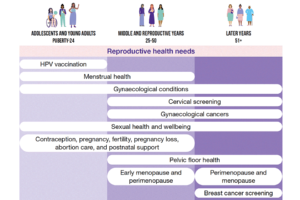by Anna Dé – WBP Policy and Advocacy Lead
Women’s Brain Project (WBP) welcomes the publication of the first ever government-led Women’s Health Strategy for England on 20 July 2022.
The publication of this 10-year strategy is a landmark moment in addressing entrenched inequalities and improving the health and wellbeing of women across the country.
Women live longer than men on average but spend about a quarter of their lives in poor health, compared with a fifth for men.
The strategy takes a life course approach, focused on understanding the changing health and care needs of women and girls across their lives, from adolescents and young adults to later life.
Women’s health across the life course

Dr Antonella Santuccione Chadha, co-founder and CEO of the Women’s Brain Project, says:
“We welcome the first Women’s Health Strategy for England to tackle the gender health gap. The Strategy includes key commitments around new research and data gathering, which aim to improve women’s health overall, including brain and mental health. We hope that other countries around the world will take similar initiatives to prioritise women’s health.”
Of particular interest for Women’s Brain Project, the strategy addresses the following points:
‘Male as default’ approach
The ‘male as default’ approach has been seen in research and clinical trials, education and training for healthcare professionals, and the design of healthcare policies and services. This has led to gaps in our data and evidence base which mean that that not enough is known about conditions that only affect women, for example menopause or endometriosis. It has meant that not enough is known about how conditions that affect both men and women impact them in different ways, for example cardiovascular disease, dementia, or mental health conditions.
Improving the representation of women in research
Research should be representative of society, with increased participation of women and other groups who have historically been under-represented in research.
Supporting more research, improving the evidence base and spearheading the drive for better data – addressing the lack of research into women’s health conditions, improving the representation of women of all demographics in research, and plugging the data gap and ensuring existing data is broken down by sex.
Within biomedical research, female animals are underrepresented in preclinical studies, including illnesses that disproportionately affect women (for example, depression and anxiety), and the effect of sex as a variable in basic research is frequently overlooked in single-sex animal and in vitro studies.
It is crucial that national policy and clinical practice is informed and updated by robust research and that women’s health research is effectively disseminated to women, practitioners, and the public.
Autistic women and girls
It is important that we address the underidentification of autism in women and girls, as well as the additional health and care disparities they may face throughout their lives.
For more on women and autism, please check out the WBP video here.
Support for unpaid carers
Overall, women are more likely to take on caring roles than men. It is also important that carers are supported to provide care as they would wish, and to do so in a way that supports their own health and wellbeing and other life chances.
Healthcare professionals
All healthcare professionals are well informed about the importance of women’s health and are enabled to provide or direct women towards the best care possible, including information on how to stay well, self-care, and advice on treatment options throughout the life course.
Data and digital
Gaps in women’s health data are better understood, and so we can tackle sex-based data gaps. Existing datasets are improved, and new datasets are established with the aim of improving women’s health outcomes, reducing disparities, and supporting a life course approach for women’s health.
Health data is collected, categorised, and analysed by relevant demographic characteristics such as ethnicity, age, sex, disability, and geography. There is consistency in how sex is defined and recorded in health datasets. This allows policymakers and the health service to better understand gaps in the data, where there are disparities, and for more effective commissioning and delivery of health services.
There is greater use of digital health technologies to empower women.
Medicines in pregnancy
Improving the safety of medicines in pregnancy and ensuring that women have high quality, accessible information to support informed decisions about their healthcare remains a priority.
Menopause
There is increased research into the menopause, including different treatments options, and impacts of menopause or menopause treatment on future health risks.
Healthcare professionals – for example cardiologists or neurologists – have a basic understanding of menopause including awareness of symptoms and future health risks associated with menopause, and signpost women to appropriate support.
Mental health and wellbeing
There is a broader and deeper understanding of the causes of differential mental health outcomes between men and women.
There is better tailored research, information and services which support all women and girls across their life course with their mental health.
It is crucial that we meet the mental health and wellbeing needs of young women and girls. Young women and girls are reporting increasing levels of ‘probable mental disorders’ and self-harm.
We are committed to addressing perinatal mental health problems. Perinatal mental health problems are those which occur during pregnancy or in the first year following the birth of a child.
For more on maternal mental health, please check out the WBP video here and our article on Post-Partum Mental Health.
Dementia
We need to ensure that greater numbers of women are participating in dementia research. There is improved awareness of dementia risk factors and experiences of care for all people with dementia including women.
In 2020 the leading cause of death for females in England was dementia and Alzheimer’s disease.
It is important that we understand the risk factors for dementia. While there is no certain way to prevent all types of dementia, there is good evidence that a healthy lifestyle can help reduce the risk of developing dementia. It is also important that we consider the impact of sex, geography and ethnicity on dementia risk factors, diagnosis and research.
Multiple Sclerosis
The strategy will look at the impact of menstruation and menopause on multiple sclerosis.
Health in the workplace
Health conditions and disabilities should no longer be a barrier to women’s participation or a positive experience in the workplace. Women feel able to speak openly about their health and to be confident that they will be supported by their employer and workplace colleagues.
Women experiencing women’s health issues such as period problems, endometriosis, fertility treatment, miscarriage, menopause should feel well supported in their workplaces. Women should also feel supported for general health conditions and disabilities that may impact women in the workplace such as cardiovascular disease, musculoskeletal conditions or mental health problems.
Women’s Brain Project, as a global organisation with a strong presence in the UK, hopes that the Women’s Health Strategy for England may be one of an increasing amount of strategies implemented in the world to address the gender health gap.



